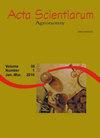Methods for estimation of genetic parameters in soybeans: an alternative to adjust residual variability
IF 1.2
4区 农林科学
Q3 AGRONOMY
引用次数: 1
Abstract
Selection practices are maximized when plant breeders have the availability of consolidated parameters, which will guide direct and indirect selection methods. This study aimed to apply a biometric alternative to minimize residual variance and maximize selection parameters by parent-progeny regression, interim controls, and mixed linear models intrinsic to breeding. The obtained data were subjected to the assumptions of the statistical model, which identified the normality and homogeneity of the residual variances and model additivity. Subsequently, two analysis scenarios were created. The first preserved all information obtained in the experiment, both from segregating families and pure-line cultivars, and was called original scenario. The other scenario preserved progeny data, but the residual variability of controls was restricted using as criterion observations contained between the interval of the first sample standard deviation. Thereby, an acceptable residue limit could be obtained. Both scenarios were submitted to three consolidated frequentist methods (genitor-progeny regression; sum of squares of augmented block design with interim controls; and mixed linear models, wherein random genetic effects are taken as weighted genetic parameters by the genealogical matrix). Restricting residual variation in parents or controls can maximize genetic parameters and genetic gains in soybean breeding. Significant heritability estimate gains were obtained in the augmented blocks with interim control approach. Mixed linear models with random genetic effects can be considered a great tool to obtain genetic parameters in experiments with a high magnitude of common and regular treatments.大豆遗传参数的估计方法:一种调整剩余变异的替代方法
当植物育种者有统一的参数可用性时,选择实践是最大化的,这将指导直接和间接的选择方法。本研究旨在应用一种生物识别替代方法,通过亲代回归、中期控制和育种固有的混合线性模型来最小化剩余方差和最大化选择参数。对所得数据进行统计模型假设,识别残差方差和模型可加性的正态性和均匀性。随后,创建了两个分析场景。第一种方案保留了从分离家系和纯系品种中获得的所有信息,称为原始方案。另一种情况保留了子代数据,但对照的剩余可变性受到限制,使用第一个样本标准差区间之间的标准观测值作为标准。因此,可以获得可接受的残留限量。这两种情况都提交了三种统一的频率分析方法(生殖-后代回归;带过渡控制的增广块设计的平方和混合线性模型,其中随机遗传效应作为加权遗传参数由谱系矩阵)。限制亲本或对照的残留变异,可以最大限度地提高大豆育种的遗传参数和遗传增益。采用中期控制方法,在扩增块中获得了显著的遗传力估计增益。具有随机遗传效应的混合线性模型可以被认为是在高强度的普通和常规处理实验中获得遗传参数的一个很好的工具。
本文章由计算机程序翻译,如有差异,请以英文原文为准。
求助全文
约1分钟内获得全文
求助全文
来源期刊

Acta Scientiarum. Agronomy.
Agricultural and Biological Sciences-Agronomy and Crop Science
CiteScore
2.40
自引率
0.00%
发文量
45
审稿时长
>12 weeks
期刊介绍:
The journal publishes original articles in all areas of Agronomy, including soil sciences, agricultural entomology, soil fertility and manuring, soil physics, physiology of cultivated plants, phytopathology, phyto-health, phytotechny, genesis, morphology and soil classification, management and conservation of soil, integrated management of plant pests, vegetal improvement, agricultural microbiology, agricultural parasitology, production and processing of seeds.
 求助内容:
求助内容: 应助结果提醒方式:
应助结果提醒方式:


